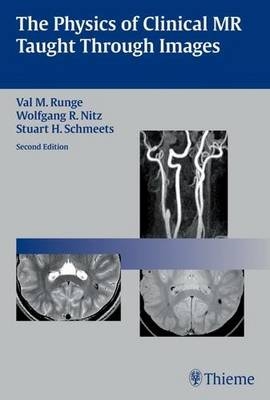
The Physics of Clinical MR Taught Through Images
Thieme Medical Publishers Inc (Verlag)
978-1-60406-161-1 (ISBN)
- Titel ist leider vergriffen;
keine Neuauflage - Artikel merken
Award Winner, RSNA 2009! This lavishly illustrated book uses high-quality images to present a practical guide to the physics of magnetic resonance. Written by internationally renowned authors, the book places an emphasis on learning visually through images of real cases rather than through mathematical equations and provides the fundamental information needed to achieve the best images in everyday clinical practice. This edition features new images and incorporates information on the latest technical advances in the field, discussing such important topics as 3 T, specific absorption rate (SAR), arterial spin labeling, continuous moving table MR, and time-resolved contrast enhanced MR angiography. Highlights: * Concise chapters make difficult concepts easy to digest*400 high-quality images and illustrations demonstrate key concepts This book is a valuable reference for radiologists and an excellent resource for residents preparing for board examinations. It is also ideal for MR technologists and students seeking to fully understand the basic principles underlying this important diagnostic tool.
John Sealy Distinguished Chair in Radiology; Professor and Chair; Department of Radiology; The University of Texas Medical Branch (UTMB); Galveston, TX, USA
Chapter 1: Components of MR Scanner Chapter 2: MR Safety: Static Management Field Chapter 3: MR Safety: Gradient Magnetic and Radiofrequency Fields Chapter 4: Radiofrequency (RF) Coils Chapter 5: Multichannel Coil Technology: Introduction Chapter 6: Multichannel Coil Technology: Body Imaging Chapter 7: Imaging Basics: k Space, Raw Data, Image Data Chapter 8: Motion Reduction: Triggering, Gating, Navigator Echoes Chapter 9: Image Resolution: Pixel and Voxel Size Chapter 10: Imaging Basics: Signal-to-Noise Ratio (SNR) Chapter 11: Imaging Basics: Contrast-to-Noise Ratio (CNR) Chapter 12: SNR Versus CNR Chapter 13: T1, T2, and Proton Density Chapter 14: Spin Echo Imaging Chapter 15: Fast Spin Echo Imaging Chapter 16: Fast Spin Echo: Reduced Refocusing Angle Chapter 17: Driven-Equilibrium Fourier Transformation (DEFT) Chapter 18: Reordering: Phase Encoding Chapter 19: Half Acquisition Single-Shot Turbo Spin Echo (HASTE) Chapter 20: Inversion Recovery: Part 1 Chapter 21: Inversion Recovery: Part 2 Chapter 22: Fluid-Attenuated IR with Fat Saturation (FLAIR FS) Chapter 23: Spoiled Gradient Echo Chapter 24: Refocused (Steady State) Gradient Echo Chapter 25: Dual-Echo Steady State (DESS) Chapter 26: Balanced Gradient Echo Chapter 27: Balanced Steady State Free Precession (b-SSFP) Chapter 28: PSIF: The Backward-Running FISP Chapter 29: Constructive Interference in a Steady State (CISS) Chapter 30: TurboFLASH, FSPGR, TFE Chapter 31: BLADE (PROPELLER) Chapter 32: Faster and Stronger Gradients: Part 1 Chapter 33: Faster and Stronger Gradients: Part 2 Chapter 34: Multislice Imaging and Concatenations Chapter 35: 3D Imaging: Basic Principles Chapter 36: 3D Imaging: MP-RAGE Chapter 37: 3D Imaging: SPACE Chapter 38: Susceptibility Weighted Imaging Chapter 39: Echo Planar Imaging Chapter 40: Flow Effects: Fast and Slow Flow Chapter 41: Phase Imaging - Flow Chapter 42: 2D Time-of-Flight MRA Chapter 43: 3D Time-of-Flight MRA Chapter 44: Flip Angle, TR, MT, and Field Strength (in 3D TOF MRA) Chapter 45: Phase Contrast MRA Chapter 46: Contrast-Enhanced MRA: Basics; Renal, Abdomen Chapter 47: Contrast-Enhanced MRA: Carotid Arteries Chapter 48: Contrast-Enhanced MRA: Peripheral Circulation Chapter 49: Dynamic MRA (TWIST/TREAT) Chapter 50: Image Composing Chapter 51: Continuous Moving Table Imaging Chapter 52: Abdomen: Motion Correction Chapter 53: Volume Interpolated Breath-Hold Examination (VIBE) Chapter 54: Magnetic resonance cholangiopancreatography (MRCP) Chapter 55: Fat Suppression: Spectral Saturation Chapter 56: Water Excitation, Fat Excitation Chapter 57: Fat Suppression: Short Tau Inversion Recovery (STIR) Chapter 58: Fat Suppression: Phase Cycling Chapter 59: Magnetization Transfer Chapter 60: Calculating T1 and T2 Relaxation Times (Calculated Images) Chapter 61: Perfusion Imaging Chapter 62: Arterial Spin Labeling (ASL) Chapter 63: Diffusion-Weighted Imaging Chapter 64: Diffusion Tensor Imaging Chapter 65: Blood oxygen level dependent imaging (BOLD) - Theory Chapter 66: Blood oxygen level dependent imaging (BOLD) - Applications Chapter 67: Proton Spectroscopy (Theory) Chapter 68: Proton Spectroscopy (Chemical Shift Imaging) Chapter 69: Number of Averages Chapter 70: Slice Thickness Chapter 71: Slice Profile Chapter 72: Slice Excitation Order (in Fast Spin Echo Imaging) Chapter 73: Slice Orientation Chapter 74: Field of View (FOV) Chapter 75: Field of View: Rectangular Chapter 76: Matrix Size: Read Chapter 77: Matrix Size: Phase Chapter 78: Partial Fourier Chapter 79: Image Interpolation (Zero Filling) Chapter 80: Parallel Imaging: Part 1 Chapter 81: Parallel Imaging: Part 2 Chapter 82: Filtering Images (to Reduce Artifacts) Chapter 83: Filtering Images (to improve SNR) Chapter 84: Geometric Distortion Chapter 85: 3D Evaluation: Image Postprocessing Chapter 86: Contrast Media: Gd Chelates with Extracellular Distribution Chapter 87: Contrast Media: Gd Chelates with Protein Binding Chapter 88: Contrast Media: Other Agents (Non-Gadolinium) Chapter 89: Cardiac Morphology Chapter 90: Cardiac Function Chapter 91: Cardiac Imaging: Myocardial Perfusion Chapter 92: Cardiac Imaging: Myocardial Viability Chapter 93: MR Mammography Dynamic Imaging Chapter 94: MR Mammography Silicone Chapter 95: Artifacts: Magnetic Susceptibility Chapter 96: Maximizing Magnetic Susceptibility Chapter 97: Artifacts: Metal Chapter 98: Chemical Shift: Sampling Bandwidth Chapter 99: Motion: Ghosting and Smearing Chapter 100: Gradient Moment Nulling Chapter 101: Spatial Saturation Chapter 102: Flow Artifacts Chapter 103: Aliasing Chapter 104: Truncation Artifacts Chapter 105: New Open MR Systems Chapter 106: Magnetic Field Effects at 3 T Chapter 107: SNR at 3 T Chapter 108: Specific Absorption Rate (SAR) Chapter 109: Advanced Receiver Coil Design Chapter 110: Acronyms
| Zusatzinfo | 274 illustrations (approx.) |
|---|---|
| Verlagsort | New York |
| Sprache | englisch |
| Maße | 155 x 230 mm |
| Einbandart | Paperback |
| Themenwelt | Medizinische Fachgebiete ► Radiologie / Bildgebende Verfahren ► Kernspintomographie (MRT) |
| Medizinische Fachgebiete ► Radiologie / Bildgebende Verfahren ► Radiologie | |
| ISBN-10 | 1-60406-161-8 / 1604061618 |
| ISBN-13 | 978-1-60406-161-1 / 9781604061611 |
| Zustand | Neuware |
| Haben Sie eine Frage zum Produkt? |
aus dem Bereich


